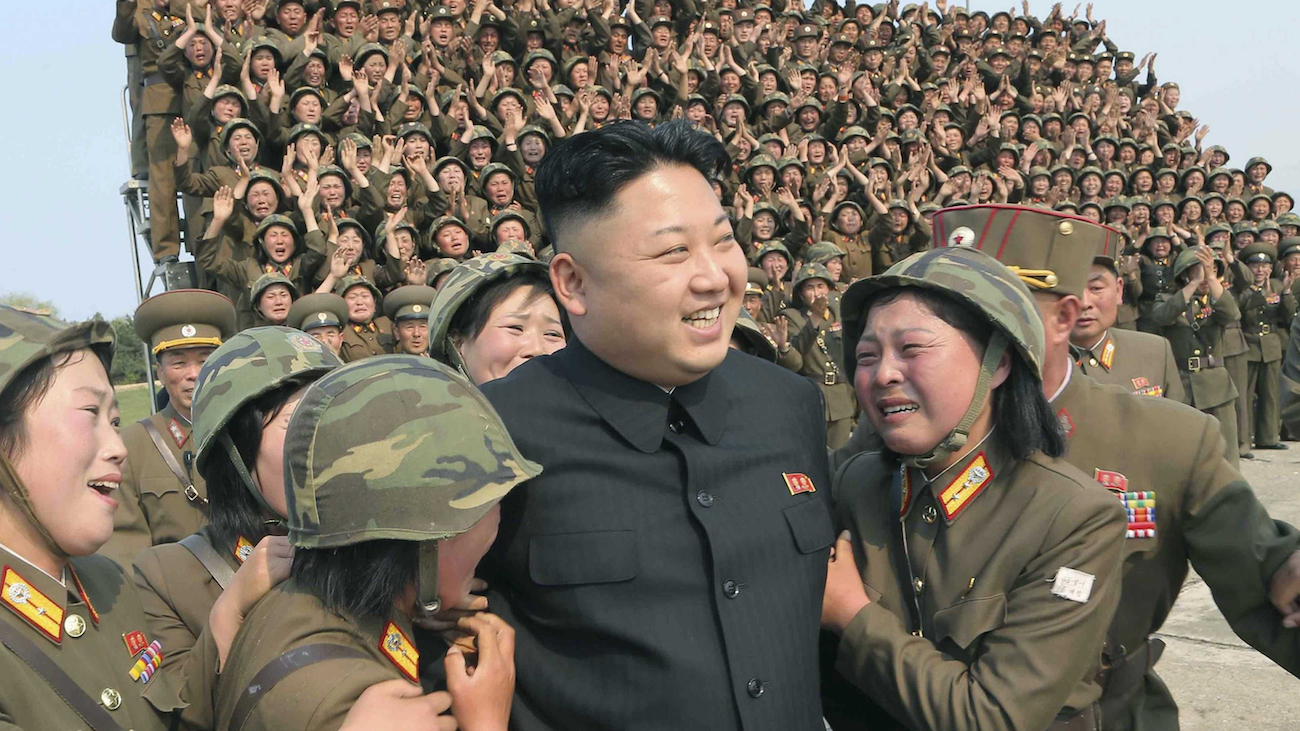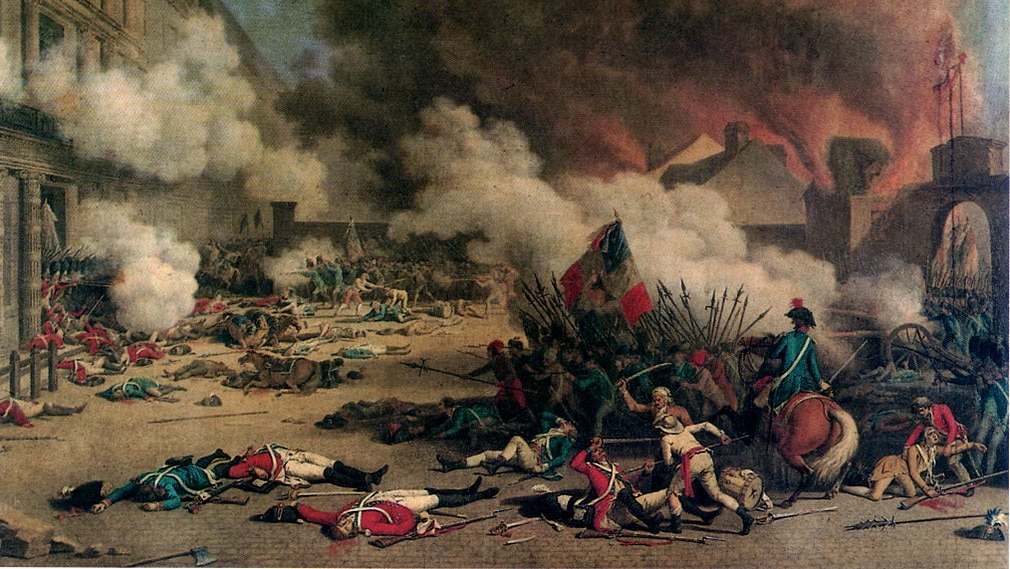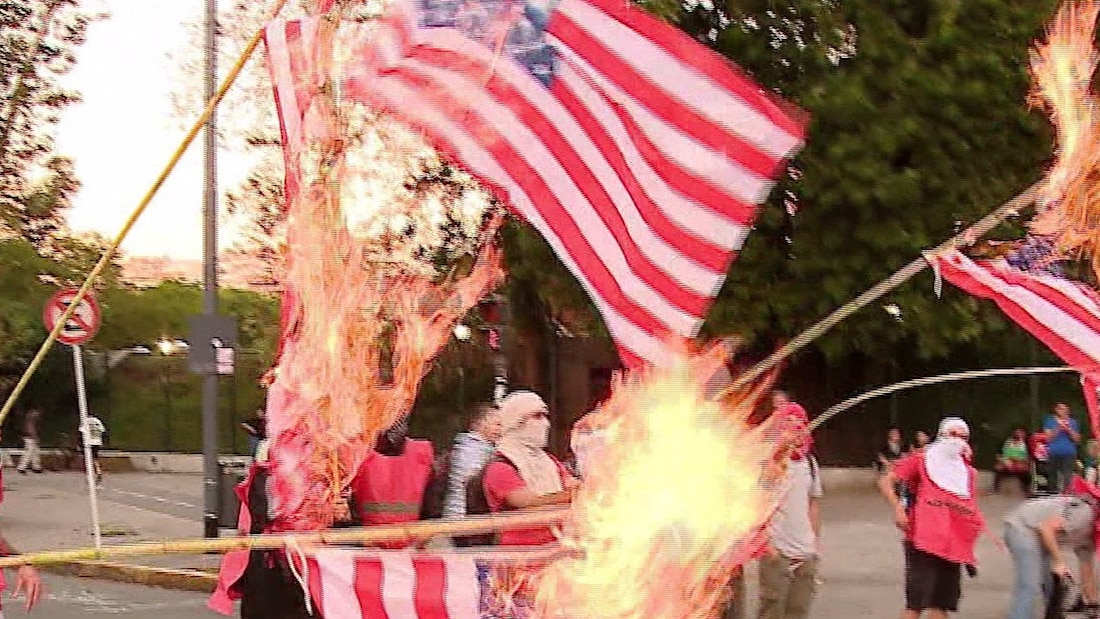While the press launches into its next anti-Trump news cycle, Democrats offer “resistance” to the Trump administration, and left-wing radicals and thugs rage in American streets, North Korea threatens world peace by developing nuclear weapons and delivery capacity for striking Japan, South Korea and Guam. We understand that the left is upset about having lost the 2016 presidential election to Donald Trump, but burying its head in the sand about the threat of nuclear war is mindboggling. Robert Wood, permanent representative of the United States to the Conference on Disarmament, warned recently, “The threat of a North Korean nuclear attack on Seoul or Tokyo is real, and it is only a matter of time before the DPRK [North Korea] develops the capacity to strike the U.S. mainland.”
Anyone who dismisses Wood too easily should heed Admiral Harry Harris, Commander of the United States Pacific Command, who testified before Congress in late April about North Korea’s ability to strike the United States with a nuclear weapon. He warned, “The crisis on the Korean peninsula is real—the worst I’ve seen…. There is some doubt within the intelligence community whether Kim Jong-un has the capacity today or whether he will soon, but I have to assume he has it, the capacity is real, and that he’s moving towards it.” Harris added, “Kim Jong-un is making progress and all nations need to take this seriously because their missiles point in all directions. If left unchecked, they will match the capability of his hostile rhetoric.”
Deconstructing the mindset of the American left today, which is obsessed with Russian-Trump collusion and impeaching Trump, can be as futile as attempting a gendered interpretation of a Hardy Boys mystery. We should not be distracted, however, about the threat a nuclearized North Korea poses. The stand-off between North Korea and the United States over nuclear and missile testing by Kim Jong-un presents an issue that is not going away soon.
The nations of the world face a North Korean regime intent on maintaining its power. Whether Kim Jong-un is a complete nut-case or a kind of wily Hitler-like madman, the history of the communist regime in North Korea reveals a ruthless will to power. Kim Jong-un, like his father and grandfather before him, orders the murder of close relatives, assassinates domestic and foreign enemies, takes down planes with innocent people, and goes to war to maintain power.
To understand the North Korean crisis today, it is necessary to place the history of the regime and its current relations with South Korea and Japan into a larger context that goes beyond the 24-hour news cycle.
The Dictatorship Called DPRK
North Korea has posed a threat to world peace since the end of World War II. The nation of North Korea began as a communist dictatorship when the Soviet-backed Kim Il-sung established the so-called Democratic People’s Republic of Korea (DPRK) on September 8, 1948. The DPRK controlled the northern part of Korea, with Pyongyang as its capital. Soviet forces in 1945 imposed a provisional government with Kim Il-sung as its leader. Kim’s ruling party, the Workers Party, was factionalized. Kim’s own “guerrilla” faction was the smallest of the factions. Kim Il-sung, following typical Stalinist tactics, gradually eliminated his opposition and strengthened his control over the country.
Once he had gained political control, Kim Il-sung set about imposing a Soviet-style economy. At first, the bulk of agricultural land was redistributed to landless peasants, but in 1954, the Kim dictatorship collectivized farming and agricultural cooperatives were merged into larger state-run entities. At the same time, again following the Stalinist model, massive state investments were made in heavy industry, state infrastructure and the military.
In the south, a democratic government under Syngman Rhee was established by a United Nations mandate with the full support of the United States. A communist-instigated insurrection in October 1948 in the south was crushed by South Korean police and the U.S. military. Kim Il-sung continued to press his ally Stalin in the Soviet Union to support a military offensive against the south to unify the country by force. Stalin finally agreed to the invasion in January 1950 following the victory of communists in China in late 1949 and the development of Soviet nuclear weapons. The United States had withdrawn most of its troops in the summer of 1949, leaving South Korea vulnerable to attack. South Korea had a weak and inexperienced army that was little more than a police force. The North Korean army had a hardened core of World War II veterans.
On June 25, 1950, North Korea launched a full-scale invasion of the south, quickly capturing Seoul. The United Nations responded by approving military action. Two days later units from U.S. forces, acting under UN auspices, arrived to block the path of invading North Korean forces. A few months later, General Douglas MacArthur in a brilliant military maneuver attacked behind North Korean lines in an amphibious landing. By October, UN forces had retaken Seoul and captured Pyongyang. In November, China forces entered the war, forcing MacArthur to abandon Pyongyang. A bloody stalemate finally ended after the two sides agreed on a border formed by the Korean Demilitarized Zone. A truce was declared without an official treaty. Technically, North and South Korea remain at war today.
In the north, Kim consolidated his power. The North Korean party vice chairman and foreign minister of DPRK was publicly executed following a show trial. Most of the leftists who had defected from the south during the war were executed, imprisoned or exiled to work in mines and agricultural cooperatives. Purges continued to allow Kim to gain a godlike status in the north.
Famine and Starvation
The Kim regime initiated a series of economic plans to bolster heavy industry and agricultural collectivism. Like other Stalinist five-year plans, Kim’s economic program failed. The Kim regime depended on a police state and foreign assistance from the Soviet Union and China. Kim Il-sung promoted “Juche,” a slogan he developed in the late 1950s proclaiming that North Korea could become a self-reliant economy and military force. While the people starved in North Korea, the ruling elite revealed an insatiable appetite for Japanese and western luxury goods.
By the 1970s, the situation had become so dire that Kim decided to default on North Korea’s foreign loans, even as he continued to build his military. When he died in 1994, his son Kim Jong-il succeeded him. A North Korean dynasty was born. In the next decade under Kim Jong-il’s rule the North Korean standard of living declined further for the 23 million people living under this barbaric regime. From 1996-99 famine left an estimated 600,000 to 900,000 North Koreans dead.
An Appalling Body Count
Attempts at reform in 2000 by stimulating agricultural production failed. Kim continued to build up the military, spending approximately 25 percent of the GNP on arms. As part of this military build-up, Kim launched a nuclear weapons program. In February 2005, Kim announced that the country had nuclear weapons. A few months later North Korea announced it had detonated an underground nuclear device. This nuclear program coincided with an active missile development program.
In December 2011, following Kim Jong-il’s death, his second son Kim Jong-um became the supreme leader of North Korea. He was promoted over Jong-il’s half-brother Kim Jong-nam, who had fallen out of favor with Jong-il because of a failed attempt in 2001 to enter Japan on a forged passport in order to visit Disneyland. In early 2017 Kim Jong-nam was assassinated by North Korean agents at an airport in Malaysia. The public assassination of Kim Jong-il’s half-brother shocked the world press, but the Kim family has a long history of assassinations and attempted assassinations against estranged Kim relatives, defectors and South Korean public figures.
In 1968, 31 North Korean commandos attacked the South Korean president’s house, known as the Blue House, leaving 90 South Koreans dead, including many civilians on a bus. In 1974, an assassination attempt on Park Geun-bye, who became president of South Korea, left his wife dead. In 1983, North Korean undercover agents killed 21 people, including four South Korean cabinet ministers, in a bomb attack in Myanmar. The most publicized attack came in 1987 when North Korean agents blew up a South Korean plane flying from Baghdad to Seoul, killing all 115 people aboard. The attack was to hamper the 1988 Seoul summer Olympics. Kim Jong-um has also ordered the murder of relatives, defectors and political opponents living abroad.
Since coming to power in 2011, Kim has executed an estimated 340 people in domestic purges. These executions have included North Korea’s top education official and the defense minister (shot with an anti-aircraft gun); a deputy premier; and Kim’s uncle, who was number two in the government. He ordered the execution of his ex-girlfriend along with a dozen well-known North Korean performers. The immediate families of these performers were forced to watch the machine gun execution, before being sent to prison camps.
Thirty-one top North Korean military leaders have been purged. The chief of North Korean state security has been dismissed and a purge is occurring in the Ministry of State Security. Human life, whether starving people or those who have escaped the hell-hole of North Korea, has no meaning to Kim. A man willing to starve his people, kill his own family members and murder anyone who stands in his way or is perceived as a threat, will have little compunction about launching a war that will leave hundreds of thousands of people dead. His own calculation will be whether war will enhance or destroy his power.
Kim Jong-um is another communist dictator whose only reliable motive is to hang on to power. It remains unclear if Kim has any rational voices around him that might counsel a wiser course of action. Kim is not just another dictator of an impoverished country; he is one with nuclear weapons.
Should We Fear a Nuclear North Korea?
Yes, Americans should fear a nuclearized North Korea. North Korea eliminated any doubts about this when in mid-May Pyongyang successfully launched the first successful test of the liquid-fueled KN N-17. North Korea claimed that its newest rocket was capable of carrying a nuclear warhead. While North Korea often inflates its military capacity for propagandistic purposes, few experts doubt that North Korea has made enormous strides in its nuclear program and delivery systems.
John Sohilling, a missile expert who has closely followed North Korea, observed that this latest test “represents a level of performance never before seen from a North Korean missile.” He added direly, “It appears to have not only demonstrated an intermediate-range ballistic missile that might enable them to reliably strike the U.S. base at Guam, but more important, may represent a substantial advance to developing an intercontinental ballistic weapon.”
North Korea has made great strides in developing atomic bombs. For decades North Korea poured its energies into developing nuclear weapons, despite sanctions and economic suffering of its people. North Korea tested its first nuclear weapon in 2006, and conducted three more tests in 2008, 2013 and 2016. The 2008 test was particularly revealing because the bomb had highly enriched uranium. North Korea claims that it can now “produce at will…smaller, lighter and diversified nuclear warheads of higher strike power.” North Korea has stockpiled about 40 kilograms of plutonium and an unknown amount of highly enriched uranium. The existing stockpile of plutonium would be enough for 20 nuclear weapons, and with the uranium stockpile they could increase their bomb capacity.
From Atomic to Hydrogen Bombs
In its January 2016 test, North Korea claimed that it used a hydrogen bomb. Whether North Korea has developed the technology necessary to miniaturize these bombs on a missile remains unclear. Professor Siegfried S. Hecker at Stanford University, one of the leading experts on North Korean weapons development, states that “we must assume that the DPRK has designed and demonstrated nuclear warheads that can be mounted on some of its short-range and perhaps medium-range missiles.” He believes that Pyongyang’s ability to fit an intercontinental missile with a nuclear warhead capable of reaching the U.S. continent is “still a long way off— perhaps 5 to 10 years, but likely doable if the program is unconstrained.” The acceleration of North Korea’s nuclear and missile technology has caught many defense experts by surprise. As Hecker bluntly notes, North Korea has “learned a lot.”
Whatever the estimated time is for North Korea to develop the capability to deliver a nuclear strike on the United States, experts agree on a number of key points: 1) North Korea’s nuclear arsenal may well hit 50 weapons by the end of President Trump’s term; 2) North Korean intermediate missiles are quickly advancing to be able to hit Japan; 3) North Korea has approximately 1,000 ballistic missiles; and 4) North Korean nuclear development must be stopped.
Can North Korea Be Constrained?
Diplomatic attempts to constrain North Korean nuclear militarization have failed. A 1994 agreement with the Clinton administration to freeze North Korea’s nuclear production facilities in return for oil and peaceful reactors fell apart in the George W. Bush administration. The blast of a second plutonium bomb just months into the Obama administration in 2009 led to further sanctions being imposed on North Korea. Carrot and stick have failed to deter North Korea.
The question before the Trump administration is whether North Korea can be constrained without military engagement. While advanced U.S. stealth airplanes would likely take control of North Korean airspace in case of a war, a preemptive strike against its nuclear sites is impractical because its nuclear facilities are too spread out to knock out quickly before Pyongyang would strike back at Seoul.
President Trump and his national security advisors understand that time is running out. A nuclear-capable North Korea is unacceptable. Japan has been seriously rattled by North Korean developments and has called for the installation of new missile defense systems that would allow retaliatory strike capability in the event Japan were attacked. New missile defense systems are being placed in South Korea. With Trump’s support, China has finally begun to apply pressure on North Korea by imposing an embargo on North Korean coal. Trump has sent a small naval armada, joined by Japanese destroyers, off North Korea’s coast. New economic sanctions are being imposed on North Korea. The noose is tightening around Kim and his communist regime.
Vice President Mike Pence made it clear where the Trump administration stands. Speaking in the Demilitarized Zone in April 2017, he frankly declared that “the era of strategic patience is over. President Trump has made it clear that the patience of the United States and our allies in this region has run out and we want to see change.”
A deadly game is being played in this region. Whatever happens, North Korea cannot be allowed to develop weapons to strike the United States. The threat of nuclear war should be a wake-up call for the left to pull its head out of the sand before it needs a shovel to bury the dead.








